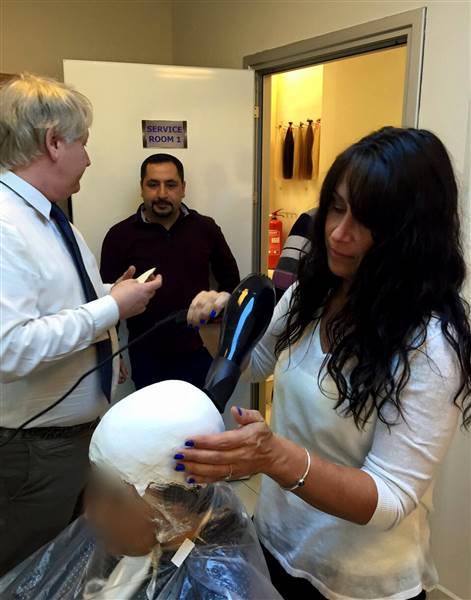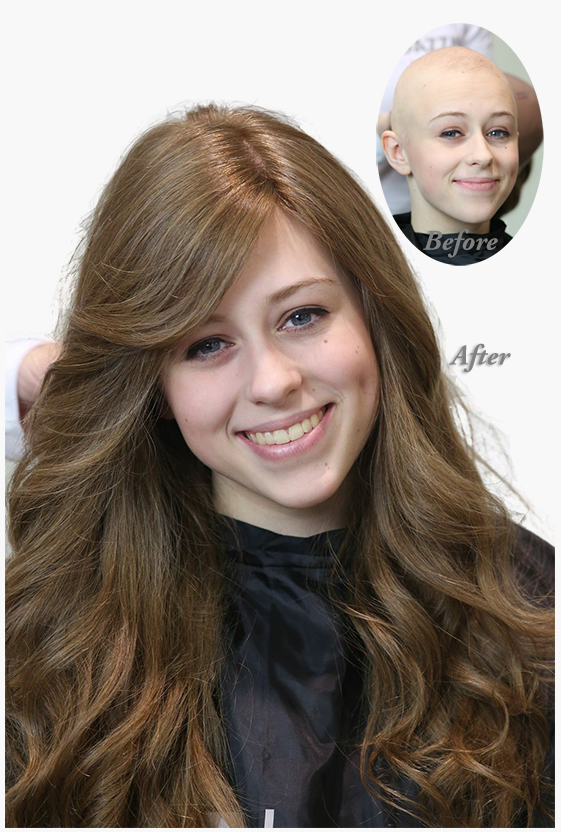Right now 3D printers are whirring away in homes, with design projects in process on desktops around the world. Small business teams set prints up the night before, and engineers come in with their coffee to check them out the next morning. Factories are pumping out automotive and aerospace components. And salons and stylists are busy printing out hair. We threw that zinger in for fun, but it’s true—and while Fast Clips down the street might not be 3D printing out your new do (yet), a number of hair specialists around the world are indeed doing so.
In yet another example of where 3D printing is coming in and saving the day where you least expected it, loss of hair may no longer be a source of emotional distress. From dreadlocks to ducktails, and from buns to beehives, those dead cells growing out of our heads tend to be an enormous part of our identity, and it’s quite amazing really how unique we can make ourselves look due to a different style or color. Taking amazing one step further however, is the idea that you may one day soon just be able to conceptualize a new style for yourself and whip it up on your desktop. This process is evolving quickly thanks to Italian company Cesare Ragazzi Laboratories, responsible for the creation of the CNC hair system which we’ve been following as they offer hope to many with their complex, integrated hair replacements that are essentially a 3D printed prosthetic—working as a ‘second scalp.’
While the conversation so far has been relegated to male pattern baldness and a host of other conditions that can cause hair to fall out, there’s one main area where everyone wants to help most—and that’s for those with or having survived cancer. With this system—although costly—many perhaps will say goodbye to the trademark turbans, hats, and bandanas. At Transitions Hair Solutions in Wall Township, New Jersey, that’s Danielle Grillo’s goal as she sees to the 3D printing of many hairpieces for cancer survivors. An extremely experienced hair stylist who has seen many fads come and go, she sees this process as being able to make the closest thing possible to real human hair. And the word ‘wig’ is not in the equation.
“It’s considered a scalp and hair prosthetic because it can be used for any kind of hair loss — related to chemotherapy, a scalp disorder, burn, autoimmune disorder, and because it can be made into whatever size is needed,” says Grillo. “Maybe you need a full head of hair or only a small area covered on the top of your head.”
Going from between $2,000 to $15,000, these semi-permanent hairpieces are completely customized—one of the greatest benefits offered via 3D printing. Grillo goes through the process of completing a mold of the person’s scalp, accompanied by precise measurements and information such as what the texture of their original hair is like, along with color, thickness—and even which direction the hair grows. Once she has all of the data and the mold, Grillo then passes everything on to Cesare Ragazzi Laboratories in Italy, where the actual 3D printing happens. It takes them about 12 weeks to finish the hairpiece and then it is sent back to the specialist who attaches it, strand by strand, to the client’s scalp.
“It’s a very, very precise, in-depth operation,” said Grillo. “It’s not for everyone; not everyone can afford it. There are other options that are still good. This is just a step above, and something different.”
Again, this is a personalized option which lends much greater benefits over traditional items—like the wig—that have been part of life for many for centuries. And while the wig serves its purpose, and many of us are certainly known to rise above discomfort when it comes to beauty (think Spanx and high heels), for those in the throes of or just coming out of cancer treatments, it’s very important to feel better whenever possible—certainly not worse.
This was a big issue for Sheri Valle of New Jersey. She suffered hair loss due to chemotherapy and radiation treatments.
“I wore regular wigs when I had cancer and was totally bald,” Valle said. “They’re hot, they feel binding. They look fake.”
“As a woman, I finally survive cancer, and now I have to go without hair?” Valle said. “I started to lose self-esteem. For a while, I wasn’t even going out at all. And I said to myself, listen, I went through all of this, so I’m going to do this for myself so I can feel like a woman again.”
Despite the cost, after the ravages of cancer and treatments, having a full head of ‘hair’ that is permanent enough to allow bathing, swimming and handle something like a windy day, is well worth it for many individuals. While the 3D printed hair does need to be maintained at the specialists every four to six weeks for a comprehensive cleaning, for the most part it is worry-free.
“Once it’s attached, they can literally do anything someone with a full head of hair can do,” Grillo said. “Seriously, go ride a jet ski! But a lot of people just tell me it’s so amazing they can shower in it.”
These CNC treatment systems can last for many years, making the investment worth it for many who may suffer hair loss from a host of other issues too, like common hereditary baldness. Currently, the 3D printed hairpieces are already available in salons and specialized treatment clinics in 12 states in the US, as well as 12 other countries. Do you know someone who might want to try one of these new hair systems? Discuss in the 3D Printed Hair for Cancer Survivors forum over at 3DPB.com.
[Source: Today / All photo credits: Transitions Hair Solutions]Subscribe to Our Email Newsletter
Stay up-to-date on all the latest news from the 3D printing industry and receive information and offers from third party vendors.
You May Also Like
3D Printing News Briefs, April 13, 2024: Robotics, Orthotics, & Hypersonics
In 3D Printing News Briefs today, we’re focusing first on robotics, as Carnegie Mellon University’s new Robotics Innovation Center will house several community outreach programs, and Ugogo3D is now working...
Rail Giant Alstom Saves $15M with 3D Printing Automation Software 3D Spark
3D Spark has entered into a three-year deal with the rail giant Alstom. Alstom, a transport behemoth with annual revenues of $16 billion, specializes in the manufacture of trains, trams,...
Meltio Expands Global Reach with New Partnerships in the Americas and Europe
Spanish 3D printing manufacturer Meltio has expanded its sales network across the globe. With the addition of three new partners in the United States, Brazil, Argentina, and Italy, Meltio aims...
3D Printing Webinar and Event Roundup: April 7, 2024
Webinars and events in the 3D printing industry are picking back up this week! Sea-Air-Space is coming to Maryland, and SAE International is sponsoring a 3D Systems webinar about 3D...




































